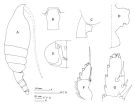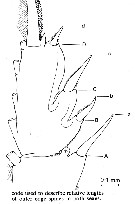
issued from : J.M. Bradford, L. Haakonssen & J.B. Jillett
in Mem. N.Z. Oceanogr. Inst., 1983, 90. [p.59, Fig.32].
Female: A, habitus (lateral right side); B, genital segment (dorsal); C, idem (lateral right side); D, genital prominence (lateral right side); E, genital field (ventral, half); F, exopod of P1; G, exopod segment 3 of P2.
Nota: -
- Posterolateral corners of metasome produced posteriorly, rounded in dorsal and lateral view and reaching almost to anterior surface of genital prominence.
- Genital segment symmetrical in dorsal and ventral view, widest part slightly anterior to middle; genital prominence large; slightly convex anterior surface of prominence meets ventral wall of genital segment at almost right angle while posterior surface slopes to meet depressed ventral wall at wide angle; genital field symmetrical; well-developed posterior lobe of genital flange points posteroventrally; posterior edge of genital field produced posteriorly into ridge, in lateral view seen as lobe behind posterior lobe of genital flange.
- Appendicular caudal setae geniculate.
- Outer lobe 1 of Mx1 with 7 drtaze.
- None of the 6 apical setae of Mx2 covered with long spines in addition to short spinules.
- None of the long setae on endopod of Mxp terminate in spinule.
- P1 exopod: Bb = 9/10 BC; Cc = BC.
- P2 exopod: Aa = AB + 1/2 Bb; Bb = 1/2 Bc; Cc = 6/7 CD; Dd = 1/5 CD.
Remarks: The genital segment of this form is similar to that of
P. sarsi, P. eltaninae, but differs from these species in having the anterior surface of the genital prominence convex instead of straight and by the depressed ventral wall of the genital segment posterior to the genital prominence. Furthermore, the dorsal wall of the genital segment curves dorsally and the outer lobe of Mx1 bears 8 setae in
P. eltaninae.





